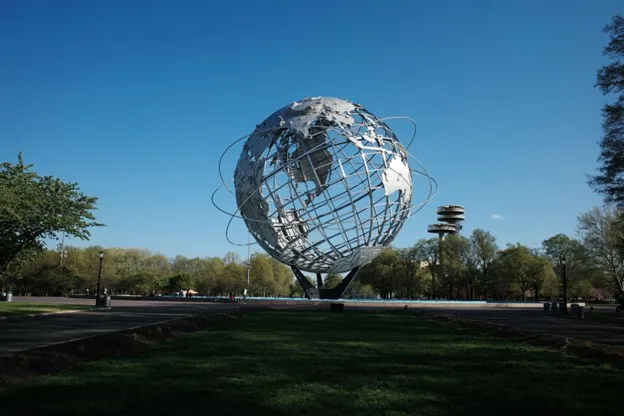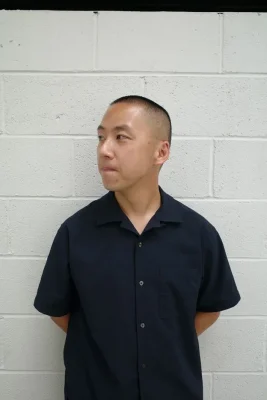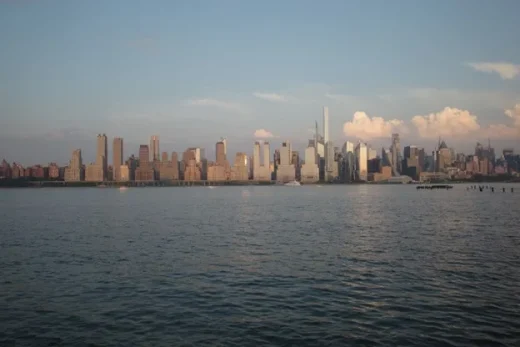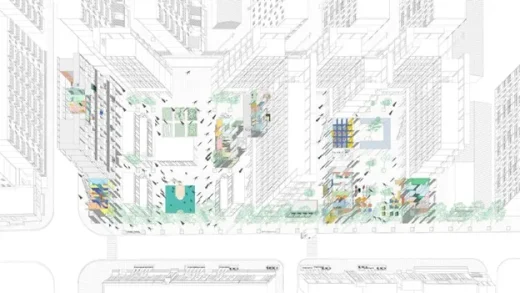Architectural designer Xiefangzheng Sun on working in public-facing architecture and designing for community, Building asset
Architectural Designer Xiefangzheng Sun on Working in Public-Facing Architecture and Designing for Community
31 October 2024

The Unisphere outside the Queens Museum, NYC. Photo Xiefangzheng Sun
By Adrian Welch
Xiefangzheng “Will” Sun is an award-winning architectural designer who is known for having worked at one of New York City’s leading urban architecture firms, LEVENBETTS, with a portfolio of world class design of major museums, libraries, foundations and other buildings that have come to redefine New York’s public spaces. Projects that he has worked on have been written up in The New York Times, Azure, Dezeen, Time Out, The Architect’s Newspaper, Architect Magazine, Brooklyn Paper, and more.
He graduated with a Bachelor of Science in Architecture at Washington University in St. Louis, and with a Masters of Architecture from Rice University in Houston. He is a former coordinator of Anti-Racism Collective at Rice University, which has organized multiple events and published various materials for standing up against hate, and has worked with a number of community organizations in St. Louis, Houston, and New York City, among others.
Sun is the recipient of the Gerry and Bob Virgil Ethic of Service Award, a prestigious annual award recognizing St. Louis community members who show service in their character. He has also won the Morris R. Pitman Travel Award, the Mildred Crocker Staff Award, the Thomas and Barbara McKittrick Award and the Alpha Rho Chi Bronze Medal, all of which recognize design ability and leadership efforts in architecture.
One recurring theme in his work is designing for public-facing spaces. It has a different meaning in today’s tech savvy world, which feels so insular. But Sun points to the humanity behind architecture to keep it palpable.
“As an architectural designer, it is too easy to design a building on the computer and become detached from the actual site and the people that use it,” he said.
It draws him to visit spaces where a building will be built. “In that sense, I try to visit the sites as often as possible to understand how the community uses it, which helps me inform the decisions and suggestions we make,” said Sun. “Luckily, most of the projects I’ve worked on are renovation projects, which forces us to visit the site to understand the dimensions and existing conditions of the building.”
Sun faced the complex issues that face our current day, like urban centers where people pay less attention to their surroundings, and have high daily smartphone usage. According to a recent report from Statistica, the daily time Americans spend on their phone is roughly five hours a day, meaning that over a lifetime, we will spend 12 years on our phones.
“We live in a world where people are less interested in physical space and see the world through phone and computer screens,” he said. “This is where design comes in; by designing spaces that are beautiful, thoughtful, and inviting, perhaps we can break the digital barrier by allowing people to gather in the spaces we create.”
Architects and designers have always been tasked with bringing communities together but that isn’t the prime goal. “I believe that as designers it is less of our duty to prescribe activities for the spaces we design,” said Sun.
“I tend to think the focus should be on creating spaces that people are drawn to and are comfortable being in.”
There are many ways to do this, as Sun recently worked on the final phase of the Queens Museum renovation in Queens, New York, a $69 million expansion led by architecture firm LEVENBETTS and is managed by the NYC Department of Design and Construction.
“We spent a lot of time thinking about how to bring more light into the museum, with transparent partitions on the interior,” he said. “We also made sure to use materials that are natural, healthy, and colorful.”
The goal was ultimately to avoid creating another typical ‘museum’ environment with white walls “that feels too serious and prohibitive,” he said.
“When a space is truly accessible and inviting to people from all backgrounds, all walks of life, and with all levels of ability, then it has the capacity to bring the communities together,” said Sun.
Sun has been a resident of Queens, New York, for years. “It’s endearing to me as a Queens resident and it is the project I’ve spent the most time with,” he said. He was working on this museum renovation since its inception and had touched every corner of the project.
Sun was responsible for drawing a large portion of the drawing set, the very framework for what the project will be built. “This included a complete restoration of the Inner South Facade that I had the pleasure of drawing and coordinating,” he explains.
The Queens Museum is a historic building that was built to host the New York City Pavilion at the New York World’s Fair in 1939 and was later used for the same purpose in 1964. It was also the headquarters of the United Nations’ General Assembly from 1946 to 1950. The historic significance of the building means that the facade work has to be approved by governmental agencies.
“I served as a liaison with these agencies to make sure the renovation project progressed smoothly through the approval process,” said Sun.
He also worked to organize and coordinate all of the team’s engineers and consultants to ensure all systems work together. “I made sure the design intention is kept consistent in all facets of the building,” Sun explains. “This means working with the structural engineer for the least visually disruptive structural members, locating the ceiling diffusers with the MEP engineers, making sure the building is evenly lit with the lighting consultants, guaranteeing acoustic privacy in all spaces with the acoustic consultants, and lastly, designing a safe foundation with the geotechnical engineers.”
This massive renovation includes a labyrinth of several complex systems. “You can imagine how massive of an undertaking this is,” said Sun. “At this point, I think I know every nook and cranny in this 400 foot long, three-story building.”
This large museum is a hub for cultural aficionados and architecture buffs alike. “New York City has always needed and thrived on its public spaces; this city does not have the luxury of spacious homes and we have no choice but to de-compress outside or in community spaces,” said Sun.
“A big part of what I believe that could help reduce this division is by talking to people with different backgrounds and viewpoints, and the community spaces help to do exactly that. In New York City everybody uses the libraries – some for the books, some for printing, some take their kids to the after-school activities. Inevitably you run into people that don’t look like you and think differently from you – and that is the beauty of our city and public spaces.
New York City skyline, image Unsplash.com
Another public-facing project that Sun worked on is on a proposal called “Fuzzy Collectives,” which aims to transform Socialist-era housing blocks in Beijing, China. These types of housing towers are all across China.
Fuzzy Collectives. Image: Xiefangzheng Sun
“The project aimed to transform these formerly housing-only buildings into spaces with ‘fuzzy’ programming, meaning that it has the flexibility to adapt into shops or co-working spaces,” said Sun.
“This proposal aims to critique the current state of Chinese urban planning, which indulges in creating spaces of ‘bigness,’ meaning tall residential towers, big malls, big cultural centers; basically impressive buildings that have no room for organic interactions between people.”
One of the pivotal moments of Sun’s architecture career was working under the award-winning firm Carlos Jiménez Studio in Houston, who helped shape his vision as an architectural designer. “What I find refreshing about Carlos’ approach is his trust in his intuition; starting from one image or sketch and following that through the end of construction,” said Sun. “We also tirelessly studied details, compositions, colors, talking over every element of the buildings we work on. I have carried this thoughtfulness with me throughout all my career.”
Sun went with Jiménez on site at locations, like the Won Buddhism Center, which the firm completed in 2021. They visited the site a few times a week. “A lot of the design decisions were made talking to the contractors and workers on site,” said Sun. “It is such a refreshing reminder that we are working with people and designing spaces for people, and that architects are not creating buildings in a vacuum.”
Over the past two years, Sun has worked as a mentor at the Architectural League of New York, where he has been mentoring local college architecture students on academic and professional growth as part of the Architectural League of New York Mentorship Program.
What makes this work special to him personally is that architecture careers need to be made accessible to everyone. “I grew up not knowing that architecture is a viable career option,” said Sun. “Architecture has historically been a profession for the privileged; you often needed to go to a school with an art program, have money for supplies, and go through many years of school coming out with relatively low pay.”
As a result, the field of architecture has been one sided. “It has been heavily biased against ethnic minorities and those who are underprivileged economically,” said Sun. “As a minority and a foreign student, so many people helped me throughout my career and I’d like to return the favor for the next generation.”
Many of the students he has worked with are immigrants and first-generation college students. “I tried to spend a lot of time showing the students the different things they can do as an architect; from big, municipal buildings, to apartment interiors, to experimental art and design objects,” said Sun. “Oftentimes, we do this by walking around New York City, looking at and talking about buildings.”
Sun also helped students with time management. “You can spend an incredible amount of time on anything and everything; models, drawings, and renderings. So I often help the students think about what they need to prioritize. Living in New York is already hard, and it is good to remind students of the bigger picture.”
Comments on this guide to Architectural Designer Xiefangzheng Sun On Working In Public-Facing Architecture and Designing For Community article are welcome.
Doors
Building Doors Posts
Increase Security for Your Front Door
How to add special features to your internal door
How to clean internal oak doors guide
Building
Residential Architecture Articles
Comments / photos for the Architectural Designer Xiefangzheng Sun On Working In Public-Facing Architecture and Designing For Community page welcome








